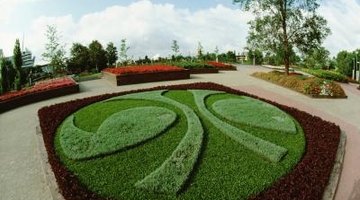The Ways Geometry Is Used in Gardening
The ways geometry is used in gardening can become confusing as the complexity increases, but even a balcony container garden grows better and looks nicer with a little geometry. Geometric principles are used by all home and professional gardeners, whether they realize it or not. In the simple measuring of the space intended for the garden and deciding how to space the plants, the principles of geometry are used.
Measurements

Each professional landscaper and home gardener must have a basic understanding of geometry. To construct a fence around the garden, the gardener must know to add the lengths of all four sides of the garden to find the total perimeter. Bags of store-bought soil and fertilizer contains a specified square footage of material, and the gardener needs to multiply the length by the width to find how many bags are needed.
Symmetry
A sense of balance and proportion is achieved in a garden of any size by choosing plants and design options with the geometric principles for symmetry in mind. The manipulation of geometric shapes by the landscaper is the basis of blueprints that ultimately transform a space into something more. For example, tall, majestic trees complement a long, horizontal stretch of yard with vertical height, whereas short shrubbery will emphasize the length.
Design
The gardener can arrange the plants geometrically to provide a seasonal flow to even the smallest garden. Geometric shapes occur naturally, without the help of the landscaper, but gardeners often put a great deal of effort into the geometric designs incorporated into the garden. By knowing how tall and how quickly each plant grows and when it blooms, intricate patterns will form with small shrubs, flowers in various bloom shades and a little grass.
Square-Foot Gardening
This method of gardening is based on the natural geometry of groups of 12-inch squares that make up 4-foot square blocks. The blocks can be smaller, or longer, than the standard 4-foot square, but by making the planting area no wider than 4 feet, every plant is easily reached from a central point. The 12-inch squares, and the spacing requirements of each plant, help space plants in a way that promotes healthy growth and provides easy access between the plants.
References
Writer Bio
Mary Carpenter started writing professionally in 2010 for an online company. She has a background studying writing and research techniques and is still achieving various degrees and accreditations. Attending ITT Technical Institute, Mary is majoring in business and accounting, working towards her associate's degree.
Photo Credits
- Photos.com/Photos.com/Getty Images
More Articles



